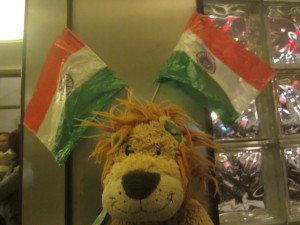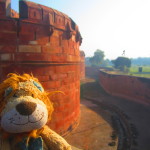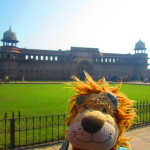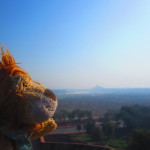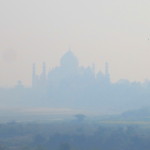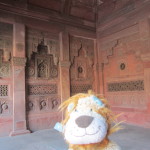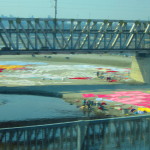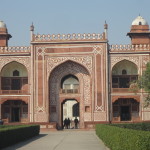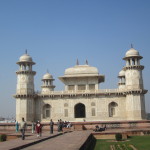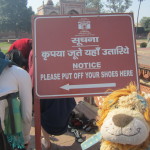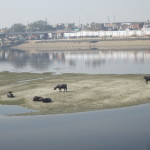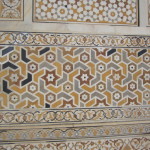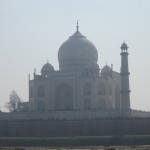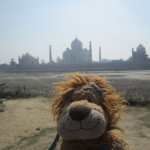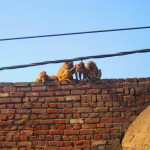Talk about perfect timing as Lewis the Lion had arrived in Agra on India’s Republic Day! He couldn’t believe his little luck! He was now in the Indian state of Uttar Pradesh (about 200 kilometres from the capital, New Delhi). He was now in one of the most major tourist destinations in the world as he had come to visit the iconic Taj Mahal. The route he had travelled also formed part of a popular tourist trek: the so-called ‘Golden Triangle’ which takes people from New Delhi, through Jaipur and eventually arriving in Agra.
Agra is famous for its splendid Mughal-era buildings, most notably the Tāj Mahal, Agra Fort and Fatehpūr Sikrī – all three of which are UNESCO World Heritage Sites.
- Lewis the Lion checks for crocodiles in the Agra Fort’s moat!
- Lewis stands outside Agra Fort
- Lewis loves the fluted archways
- Lewis the Lion sees the Taj Mahal for the very first time
- The Taj Mahal silhouetted in the distance
- The rooms capture the convergence of religions
Lewis the Lion’s first stop was to visit the Agra Fort and what a place! It was more like a city than a fort it was so huge! Lewis the Lion let his imagination run loose as he thought about how it would have been at the height of the Mughal’s power. (There was originally a fort there from the 11th Century but the one we see today was started in 1565 under Akbar the Great’s rule and completed 8 years later). With its high, red-sandstone walls, surrounded by a crocodile moat, the opulence would have been magnificent with gem stones encrusted into the palace walls and decorations. However, he thought that the Mughals seemed like a nasty lot with one son, Aurangzeb (the great-grandson of Akbar the Great) putting his father, Shah Jahan (the one that build the Taj Mahal for his wife) under house arrest, whilst killing two of his brothers! Apparently Shah Jahan was locked up in the Muasamman Burj, a tower with a marble balcony with a view of the Taj Mahal. It was here that Lewis the Lion got very excited as this is where he got his very first glimpse of the Taj Mahal himself!
Like in the Amer Fort in Jaipur, there were many chambers for different wives and concubines who would live (almost as prisoners) at the fort and entertain these rulers. No wonder this fort was so enormous!
Akbar the Great, the 3rd Mughal Emperor (and son of Humayun – whose tomb Lewis the Lion had visited in New Delhi), let his wife practise Hinduism and she had a temple within the fortress. He was tolerant of many religions and perhaps wanted to bring religious unity across his kingdom so created his own religion Din-i-Ilahi which encompassed elements of the Islamic, Hindu, Christian and Zoroastrianism religions – some of which is still evident in the fort today. He was also a great advocate of art, culture and reading and there was a library with over 24,000 volumes in the fort written in a range of languages. In his court were scholars, translators, artists, calligraphers, scribes, bookbinders, readers, holy men of many faiths, poets, architects and artisans from all over the world for study and discussion. Lewis the Lion thought that if he had been alive back then, he would have loved to have been a part of Akbar the Great’s court! That would have definitely intrigued his curious mind to have been surrounded by such erudite people!
From learning some of the impressive secrets from the Agra Fort, Lewis the Lion and his travelling friends then went on to visit somewhere called the ‘Baby Taj Mahal.’ At first he was expecting to see a miniature version of the Taj Mahal but that was not the case. Instead it was another beautiful mausoleum built in the Indo-Islamic style, as you can see in the pictures below. Its other nickname is the ‘Jewel Box’ but its real name is the Tomb of I’timād-ud-Daulah! Some say that this mausoleum shows the transition in style of Mughal architecture from red sandstone with marble decoration to pure marble as seen in the Taj Mahal. It was commissioned by the daughter of a rich family, Nūr Jahān, for her father Mirzā Ghiyās Beg (who was also the grandfather of one of the wives of Shāh Jahān – the emperor who built the Taj Mahal). Lewis the Lion was very impressed by this peaceful haven in the middle of a chaotic city, with its beautiful design and gardens. Yet again, he delighted in the cheeky squirrels running past him and smiled to himself as he watched children wading in the waters below along with water buffaloes.
- Washing left to dry on the river bank
- The entrance to the Baby Taj
- Itimad-Ud-Daula
- Time to take your shoes off!
- Looking onto the Yamuna River
- Children wave up at Lewis the Lion
- Another beautiful mausoleum in Agra
- The mausoleum has exquisite inlay work
- ‘A dream in marble’
- Lewis the Lion sees the Taj Mahal across the Yamuna River
- Monkeys run along the rooftops
- Locals carry bracken on their heads
As the group of travellers left to head now towards the famous Taj Mahal, Lewis the Lion delighted in the sights from the roadside, including a colourful patchwork of laundry drying on the banks of the river, locals carrying bracken and hundreds of monkeys scampering along the city rooftops. India surely was full of surprises! He gasped in amazement as he saw the Taj Mahal – this time from across the Yamuna River. It really was an architectural beauty. He just couldn’t wait to visit now after lunch!
Lewis imagined what it would have been like to have been in the court of Akbar the Great, the Mughal Emperor in the 16th Century. Imagine that you had a time capsule and could be transported back in time to any point in history. What time period would you like to go back to and why? Who would you like to meet and why? What questions would you want to ask them?

